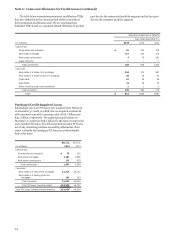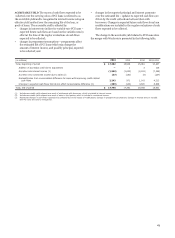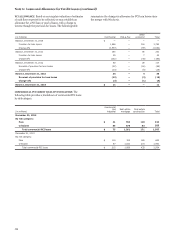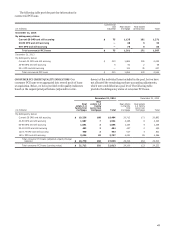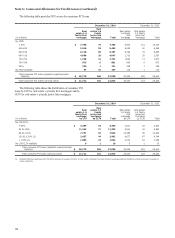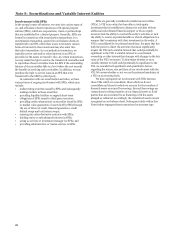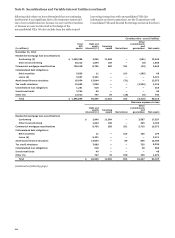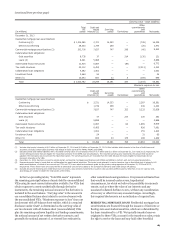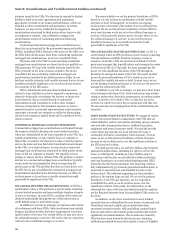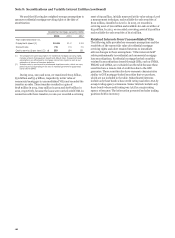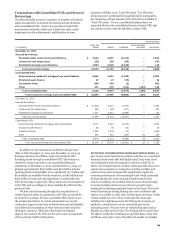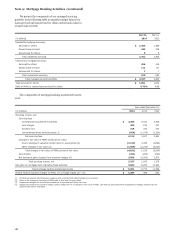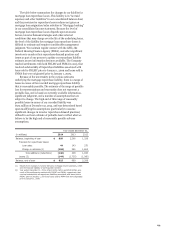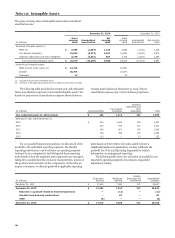Wells Fargo 2014 Annual Report Download - page 186
Download and view the complete annual report
Please find page 186 of the 2014 Wells Fargo annual report below. You can navigate through the pages in the report by either clicking on the pages listed below, or by using the keyword search tool below to find specific information within the annual report.Note 8: Securitizations and Variable Interest Entities (continued)
interests issued by the VIEs. We also may be exposed to limited
liability related to recourse agreements and repurchase
agreements we make to our issuers and purchasers, which are
included in other commitments and guarantees. In certain
instances, we may service residential mortgage loan
securitizations structured by third parties whose loans we did
not originate or transfer. Our residential mortgage loan
securitizations consist of conforming and nonconforming
securitizations.
Conforming residential mortgage loan securitizations are
those that are guaranteed by the government-sponsored entities
(GSEs), including GNMA. Because of the power of the GSEs over
the VIEs that hold the assets from these conforming residential
mortgage loan securitizations, we do not consolidate them.
The loans sold to the VIEs in nonconforming residential
mortgage loan securitizations are those that do not qualify for a
GSE guarantee. We may hold variable interests issued by the
VIEs, primarily in the form of senior securities. We do not
consolidate the nonconforming residential mortgage loan
securitizations included in the table because we either do not
hold any variable interests, hold variable interests that we do not
consider potentially significant or are not the primary servicer
for a majority of the VIE assets.
Other commitments and guarantees include amounts
related to loans sold that we may be required to repurchase, or
otherwise indemnify or reimburse the investor or insurer for
losses incurred, due to material breach of contractual
representations and warranties as well as other retained
recourse arrangements. The maximum exposure to loss for
material breach of contractual representations and warranties
represents a stressed case estimate we utilize for determining
stressed case regulatory capital needs and is considered to be a
remote scenario.
COMMERCIAL MORTGAGE LOAN SECURITIZATIONS
Commercial mortgage loan securitizations are financed through
the issuance of fixed or floating-rate asset-backed securities,
which are collateralized by the loans transferred to the VIE. In a
typical securitization, we may transfer loans we originate to
these VIEs, account for the transfers as sales, retain the right to
service the loans and may hold other beneficial interests issued
by the VIEs. In certain instances, we may service commercial
mortgage loan securitizations structured by third parties whose
loans we did not originate or transfer. We typically serve as
primary or master servicer of these VIEs. The primary or master
servicer in a commercial mortgage loan securitization typically
cannot make the most significant decisions impacting the
performance of the VIE and therefore does not have power over
the VIE. We do not consolidate the commercial mortgage loan
securitizations included in the disclosure because we either do
not have power or do not have a variable interest that could
potentially be significant to the VIE.
COLLATERALIZED DEBT OBLIGATIONS (CDOs) A CDO is a
securitization where a VIE purchases a pool of assets consisting
of asset-backed securities and issues multiple tranches of equity
or notes to investors. In some CDOs, a portion of the assets are
obtained synthetically through the use of derivatives such as
credit default swaps or total return swaps.
In addition to our role as arranger we may have other forms
of involvement with these CDOs. Such involvement may include
acting as liquidity provider, derivative counterparty, secondary
market maker or investor. For certain CDOs, we may also act as
the collateral manager or servicer. We receive fees in connection
with our role as collateral manager or servicer.
We assess whether we are the primary beneficiary of CDOs
based on our role in them in combination with the variable
interests we hold. Subsequently, we monitor our ongoing
involvement to determine if the nature of our involvement has
changed. We are not the primary beneficiary of these CDOs in
most cases because we do not act as the collateral manager or
servicer, which generally denotes power. In cases where we are
the collateral manager or servicer, we are not the primary
beneficiary because we do not hold interests that could
potentially be significant to the VIE.
COLLATERALIZED LOAN OBLIGATIONS (CLOs) A CLO is a
securitization where an SPE purchases a pool of assets consisting
of loans and issues multiple tranches of equity or notes to
investors. Generally, CLOs are structured on behalf of a third
party asset manager that typically selects and manages the assets
for the term of the CLO. Typically, the asset manager has the
power over the significant decisions of the VIE through its
discretion to manage the assets of the CLO. We assess whether
we are the primary beneficiary of CLOs based on our role in
them and the variable interests we hold. In most cases, we are
not the primary beneficiary because we do not have the power to
manage the collateral in the VIE.
In addition to our role as arranger, we may have other forms
of involvement with these CLOs. Such involvement may include
acting as underwriter, derivative counterparty, secondary market
maker or investor. For certain CLOs, we may also act as the
servicer, for which we receive fees in connection with that role.
We also earn fees for arranging these CLOs and distributing the
securities.
ASSET-BASED FINANCE STRUCTURES We engage in various
forms of structured finance arrangements with VIEs that are
collateralized by various asset classes including energy contracts,
auto and other transportation leases, intellectual property,
equipment and general corporate credit. We typically provide
senior financing, and may act as an interest rate swap or
commodity derivative counterparty when necessary. In most
cases, we are not the primary beneficiary of these structures
because we do not have power over the significant activities of
the VIEs involved in them.
In fourth quarter 2014, we sold $8.3 billion of government
guaranteed student loans, including the rights to service the
loans, to a third party, resulting in a $217 million gain. In
connection with the sale, we provided $6.5 billion in floating-
rate loan financing to an asset backed financing entity (VIE)
formed by the third party purchaser. Our financing, which is
fully collateralized by government guaranteed student loans, is
measured at amortized cost and classified in loans on the
balance sheet. The collateral supporting our loan includes a
portion of the student loans we sold. We are not the primary
beneficiary of the VIE and, therefore, are not required to
consolidate the entity as we do not have power over the
significant activities of the entity. For information on the
estimated fair value of the loan and related sensitivity analysis,
see the Retained Interests from Unconsolidated VIEs section in
this Note.
In addition, we also have investments in asset-backed
securities that are collateralized by auto leases or loans and cash.
These fixed-rate and variable-rate securities have been
structured as single-tranche, fully amortizing, unrated bonds
that are equivalent to investment-grade securities due to their
significant overcollateralization. The securities are issued by
VIEs that have been formed by third party auto financing
institutions primarily because they require a source of liquidity
184


